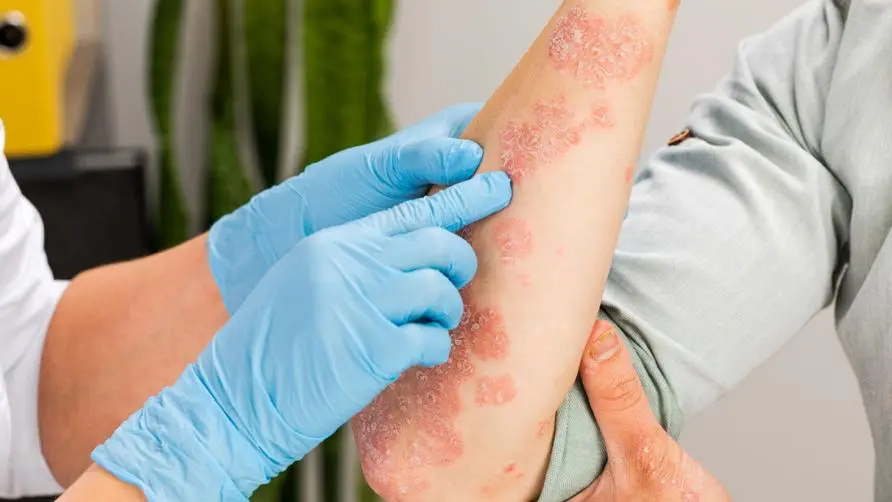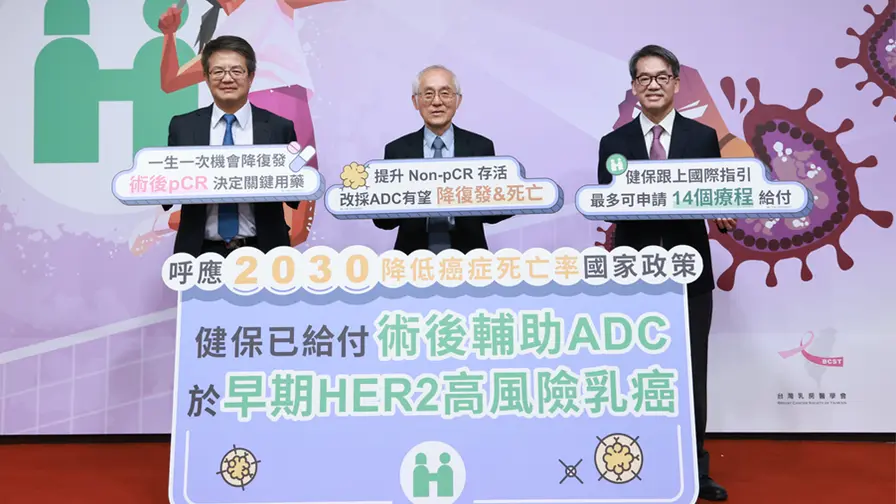Combine the advantages of chemotherapy and targeted therapy! 1 drug accurately treats HER2 "weakly positive" breast cancer

Half of metastatic breast cancer patients fall into this category! Is “HER2 weak positivity” a potential new type of breast cancer?
The 52-year-old patient named Shi had breast cancer relapse about five years ago, but because he had to take care of his cancer-stricken mother and sick father-in-law, he was unable to fully receive treatment. He did not seek medical treatment again until the breast tumor grew larger and spread to multiple places in the lungs. I originally thought it was triple-negative breast cancer, but after asking the doctor, I found out that I actually had “HER2 weakly positive” breast cancer. Although anti-HER2 targeted drugs are not suitable for it, antibody-drug complexes (ADC, Antibody-Drug) commonly known as “magic bullets” can be used. Conjugates) medicines keep you alive.
Jiang Kunjun, director of the Harvard Health Management Center and vice president of Minsheng General Hospital, pointed out that more than 15,000 new people in Taiwan are diagnosed with breast cancer every year, which is equivalent to one more breast cancer patient every 35 minutes. Among all breast cancer patients, about 1/5 have “HER2-positive” breast cancer that is suitable for treatment with anti-HER2 target drugs. In order to realize her wish to spend more time with her child, Ms. Shi decided to give herself another chance and bravely cooperated with the doctor for treatment.
Due to the overexpression of the HER2 gene, this type of breast cancer not only grows rapidly, but is also prone to resistance to some treatment drugs. Even if patients complete surgery and other treatments, they have a higher chance of recurrence and metastasis. Fortunately, the advent of targeted drugs targets the HER2 receptor that allows cancer cells to divide and grow rapidly, changing the fate of HER2 breast cancer patients.
The new generation of ADC drugs increases treatment opportunities. Doctors: Survival period of second-line treatment is extended to 2 and a half years.
HER2 weak positivity (HER2-low) can be said to be a new classification of HER2 breast cancer. Dr. Rao Kunming, deputy director of the E-Da Cancer Treatment Hospital, pointed out that after pathologists obtain tissue sections from breast cancer patients, they will use immunohistochemical staining (IHC) to examine the amount of HER2 protein on the cancer cell membrane, from low to high according to its expression level. , divided into 4 types of results: “0, 1+, 2+, 3+”. Among them, only patients with 3+, or those with 2+ who are then tested positive by fluorescence testing, are “HER2-positive breast cancers” that are suitable for current anti-HER2 target drugs.
As for those whose IHC test is 2+, but FISH test is negative, or whose IHC test is only 1+, it shows that the expression of HER2 in breast cancer is low, which is not suitable for current anti-HER2 target drugs and is not enough to be classified as HER2 positive. In the past, such patients could only choose to use anti-hormone therapy, immunotherapy or simple chemotherapy based on whether they were hormone-positive, whether the PD-L1 expression level was high enough, whether they had BRCA gene mutations, etc.
However, in recent years, these HER2 weakly positive breast cancer patients who are not suitable for anti-HER2 target drugs are expected to be suitable for precise treatment with ADC drugs. It is estimated that in addition to the 30% of breast cancers for which HER2 is truly undetectable, and the 20% of HER2-positive patients, about 50% of breast cancer patients are “HER2 weakly positive breast cancers,” and it is expected that there will be an additional precision treatment option.
“Bystander Effect” Overcomes Tumor Heterogeneity: 3 Major Clinical Features of New Generation ADC Drugs
Dr. Jiang Kunjun pointed out that unlike the traditional combination of targeted drugs and systemic chemotherapy, ADC drugs directly combine target drugs and chemotherapy drugs, using the specificity of the target drugs to accurately deliver chemotherapy drugs into cancer cells. Need to be administered separately. Because targeted drugs are used to directly deliver chemotherapy drugs to target cancer cells, the effect is more precise and the side effects are smaller than before.
Compared with the past ADC drugs, which can only carry 4 small molecule cytotoxic drugs, the new generation ADC drugs can carry 8 small molecule cytotoxic drugs, and the therapeutic benefits are more significant. “The advantage of ADC is that wherever the cancer cells grow, the concentration of the drug will be the same. Compared with the imprecise poisoning of traditional chemotherapy drugs and the limited treatment of target drugs, ADC drugs combine the advantages of both to increase the therapeutic effect and safety.”
Dr. Jiang Kunjun explained that in addition to the type of target drug, the number of small molecule drugs carried, and the toxicity of small molecule chemotherapy drugs, which affect the ability of ADC drugs to kill cancer cells, the “connection” used to connect monoclonal antibodies and small molecule chemotherapy drugs Linker design can also affect drug effects. The linker must allow the ADC to remain stable in the blood circulation without prematurely releasing the drug to the incorrect location, bringing the drug into the tumor through endocytosis, and releasing the chemotherapy drug in a timely manner to poison the tumor cells.
In particular, the chemotherapeutic drugs linked to some ADC drugs have lipophilic properties and better cell membrane permeability. They can penetrate the tumor cell membrane and have a toxic effect on neighboring cancer cells, triggering the so-called “bystander effect.” . In other words, not only the cancer cells that swallow the ADC drug will be poisoned, but the surrounding cancer cells that have no target for attack will also be affected.
Dr. Jiang Kunjun explained that cancer tumors have so-called “heterogeneity”. Not all cells in breast cancer tumors of the same patient may have HER2 expression; and the new generation of ADC drugs can also poison the surrounding cells through the bystander effect. cancer cell. Dr. Rao Kunming said that traditional monoclonal antibodies can only kill HER2-positive tumor cells, but the new generation ADC can also kill HER2-weakly positive tumors.
Does the new generation of drugs have side effects of pneumonia and vomiting? Taking medication as prescribed by your doctor can help relieve symptoms
Dr. Rao Kunming pointed out that in the past, ADC drugs were used as second-line treatment for patients with metastatic HER2-positive breast cancer, and the median survival without disease progression was less than one year. Now, not only the median survival without disease progression for patients with metastatic HER2-positive breast cancer can be extended to Nearly 2 and a half years. Patients with weak HER2 positivity also experienced meaningful improvements in disease progression-free survival and overall survival.
“HER2 will no longer be a dichotomy between positive and non-positive. In the future, there will be a middle ground, that is, weak positivity!” Dr. Rao Kunming pointed out that progressively more accurate classification methods will make targeted treatment of breast cancer more precise. However, although ADC drugs target cancer cells through targeted drugs, because they carry chemotherapy drugs, they may be accompanied by side effects such as pneumonia, stomach pain, nausea and vomiting while killing cancer cells. Patients are reminded to follow medical advice to help manage side effects. .
Finally, Dr. Rao Kunming emphasized that compared with the five-year survival rate of early-stage breast cancer, which is more than 94%, the five-year survival rate of late-stage breast cancer is only about 35%, which shows that early detection and early treatment are the best weapons against breast cancer. It is recommended that female groups actively undergo routine health examinations through colleges and universities, companies, or mammography examinations every two years (women aged 45-69 years old, women aged 40-44 years old who have second-class blood relatives who have suffered from breast cancer ) to detect cancer cells early.
Further reading:





